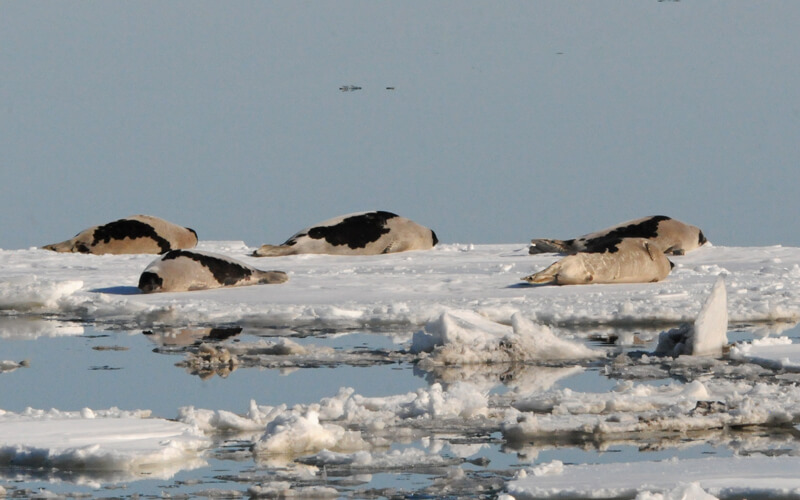Before tackling this question, here are a few tidbits regarding our St. Lawrence whales. Between 30 and 50 belugas were seen swimming off Les Bergeronnes on February 27: mainly white individuals accompanied by a few grays. On March 4, a blue whale lingered for two hours near the shores of Godbout. The day before, two large distinct spouts were spotted in Moisie by Anik Boileau, director of the Sept-Îles Education and Research Centre (CERSI). She hesitates whether to identify them as blue whales or fin whales. These reports can be seen as a sign of spring. Indeed, the most recent whale sighting that had been shared with us dates back to early January.
Several dozen or even hundreds of harp seals have been huddled together on the ice in Sept-Îles. If one gets a little closer, it is even possible to hear them, as they are quite “loquacious” animals. They emit over a dozen different vocalizations, particularly when under water. In the Arctic, they are most likely quieter when out of the water to avoid being detected by a lurking polar bear, their main predator.
Seals in general produce a wide range of sounds: barks, grunts, squeals, chirps, whistles, etc., especially males in the breeding season to attract females or compete with other males. These sounds are made both on land and under water.
In summer, captains sailing in proximity to seal haulouts – like the ones used by gray seals on Île Rouge or Île Blanche in the St. Lawrence Estuary – can hear their loud cries. According to their reports: “It’s as if we’re in the middle of the forest and surrounded by wolves”. In fact, in French, seals are sometimes referred to as “sea wolves”. Depending on the region, this age-old designation is sometimes associated with one species in particular.
It’s not just through sounds that seals are able to communicate. Mothers rub their snout against that of their young and sniff it. This is how they recognize their offspring. They also produce a few simple vocalizations to maintain close contact with their newborn, especially when they are away feeding. However, these particular sounds are probably not used beyond weaning.

When out of the water, harbour seals often motion with their heads and front flippers to signal to other members of their species to keep a certain distance. The hooded seal, on the other hand, uses its inflatable sac – which forms a hood when distended and hangs off the end of the animal’s snout when relaxed – and blows up the large red balloon-like membrane separating its nostrils (nasal septum), shaking it fervently. This behaviour is believed to be intended to impress rivals during courtship displays.
So, on your next walk along the shores of the river, listen carefully. Perhaps you will hear the jabbering of seals… Or the blow of a whale.





